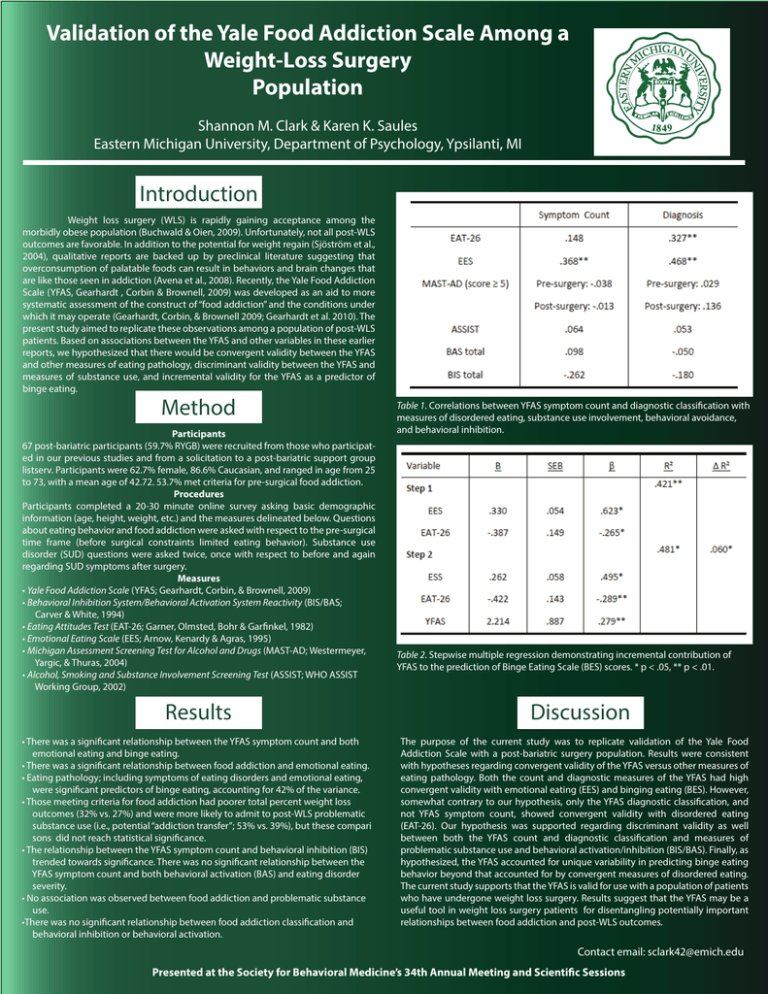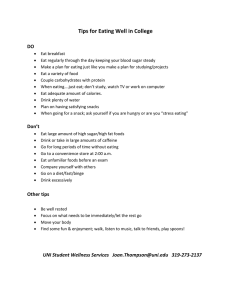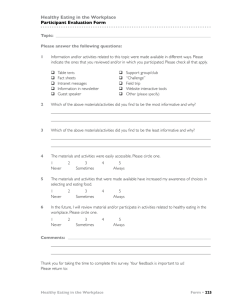Validation of the Yale Food Addiction Scale Among a Weight-Loss Surgery Population
advertisement

Validation of the Yale Food Addiction Scale Among a Weight-Loss Surgery Population Shannon M. Clark & Karen K. Saules Eastern Michigan University, Department of Psychology, Ypsilanti, MI Introduction Weight loss surgery (WLS) is rapidly gaining acceptance among the morbidly obese population (Buchwald & Oien, 2009). Unfortunately, not all post-WLS outcomes are favorable. In addition to the potential for weight regain (Sjöström et al., 2004), qualitative reports are backed up by preclinical literature suggesting that overconsumption of palatable foods can result in behaviors and brain changes that are like those seen in addiction (Avena et al., 2008). Recently, the Yale Food Addiction Scale (YFAS, Gearhardt , Corbin & Brownell, 2009) was developed as an aid to more systematic assessment of the construct of “food addiction” and the conditions under which it may operate (Gearhardt, Corbin, & Brownell 2009; Gearhardt et al. 2010). The present study aimed to replicate these observations among a population of post-WLS patients. Based on associations between the YFAS and other variables in these earlier reports, we hypothesized that there would be convergent validity between the YFAS and other measures of eating pathology, discriminant validity between the YFAS and measures of substance use, and incremental validity for the YFAS as a predictor of binge eating. Method Participants 67 post-bariatric participants (59.7% RYGB) were recruited from those who participated in our previous studies and from a solicitation to a post-bariatric support group listserv. Participants were 62.7% female, 86.6% Caucasian, and ranged in age from 25 to 73, with a mean age of 42.72. 53.7% met criteria for pre-surgical food addiction. Procedures Participants completed a 20-30 minute online survey asking basic demographic information (age, height, weight, etc.) and the measures delineated below. Questions about eating behavior and food addiction were asked with respect to the pre-surgical time frame (before surgical constraints limited eating behavior). Substance use disorder (SUD) questions were asked twice, once with respect to before and again regarding SUD symptoms after surgery. Measures • Yale Food Addiction Scale (YFAS; Gearhardt, Corbin, & Brownell, 2009) • Behavioral Inhibition System/Behavioral Activation System Reactivity (BIS/BAS; Carver & White, 1994) • Eating Attitudes Test (EAT-26; Garner, Olmsted, Bohr & Garfinkel, 1982) • Emotional Eating Scale (EES; Arnow, Kenardy & Agras, 1995) • Michigan Assessment Screening Test for Alcohol and Drugs (MAST-AD; Westermeyer, Yargic, & Thuras, 2004) • Alcohol, Smoking and Substance Involvement Screening Test (ASSIST; WHO ASSIST Working Group, 2002) Results • There was a significant relationship between the YFAS symptom count and both emotional eating and binge eating. • There was a significant relationship between food addiction and emotional eating. • Eating pathology; including symptoms of eating disorders and emotional eating, were significant predictors of binge eating, accounting for 42% of the variance. • Those meeting criteria for food addiction had poorer total percent weight loss outcomes (32% vs. 27%) and were more likely to admit to post-WLS problematic substance use (i.e., potential “addiction transfer”; 53% vs. 39%), but these compari sons did not reach statistical significance. • The relationship between the YFAS symptom count and behavioral inhibition (BIS) trended towards significance. There was no significant relationship between the YFAS symptom count and both behavioral activation (BAS) and eating disorder severity. • No association was observed between food addiction and problematic substance use. •There was no significant relationship between food addiction classification and behavioral inhibition or behavioral activation. Table 1. Correlations between YFAS symptom count and diagnostic classification with measures of disordered eating, substance use involvement, behavioral avoidance, and behavioral inhibition. Table 2. Stepwise multiple regression demonstrating incremental contribution of YFAS to the prediction of Binge Eating Scale (BES) scores. * p < .05, ** p < .01. Discussion The purpose of the current study was to replicate validation of the Yale Food Addiction Scale with a post-bariatric surgery population. Results were consistent with hypotheses regarding convergent validity of the YFAS versus other measures of eating pathology. Both the count and diagnostic measures of the YFAS had high convergent validity with emotional eating (EES) and binging eating (BES). However, somewhat contrary to our hypothesis, only the YFAS diagnostic classification, and not YFAS symptom count, showed convergent validity with disordered eating (EAT-26). Our hypothesis was supported regarding discriminant validity as well between both the YFAS count and diagnostic classification and measures of problematic substance use and behavioral activation/inhibition (BIS/BAS). Finally, as hypothesized, the YFAS accounted for unique variability in predicting binge eating behavior beyond that accounted for by convergent measures of disordered eating. The current study supports that the YFAS is valid for use with a population of patients who have undergone weight loss surgery. Results suggest that the YFAS may be a useful tool in weight loss surgery patients for disentangling potentially important relationships between food addiction and post-WLS outcomes. Contact email: sclark42@emich.edu Presented at the Society for Behavioral Medicine’s 34th Annual Meeting and Scientific Sessions







